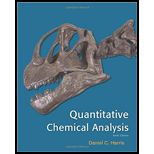
Concept explainers
Interpretation:
The given table has to be filled using Boltzmann distribution and why
Explanation of Solution
Calculation of Wavelength for Sodium;
To calculate wavelength the formula that can be used is,
In the problem statement it is given that
Therefore, for Sodium,
Calculation of Wavelength for Copper;
To calculate wavelength the formula that can be used is,
In the problem statement it is given that
Therefore, for Copper,
Calculation of Wavelength for Bromine;
To calculate wavelength the formula that can be used is,
In the problem statement it is given that
Therefore, for Bromine,
To calculate
For Sodium,
For Copper,
For Bromine,
To calculate
For Sodium,
For Copper,
For Bromine,
The completed table can be given as,
| Element |
|
|
|
| Excited state energy(eV) | 2.1 | 3.78 | 8.04 |
| Wavelength (nm) | 591 | 328 | 154 |
| Degeneracy Ratio (
| 3 | 3 | 2/3 |
|
|
|
|
|
|
|
|
|
|
Bromine is not readily in absorption spectroscopy because the lowest excited state itself requires far-UV radiation for excitation. The excited state lies at such high energy which is not sufficiently populated to obtain the intensity for optical emission.
Want to see more full solutions like this?
Chapter 21 Solutions
Quantitative Chemical Analysis 9e & Sapling E-Book and Homework for Quantitative Chemical Analysis (Six Month Access) 9e
 ChemistryChemistryISBN:9781305957404Author:Steven S. Zumdahl, Susan A. Zumdahl, Donald J. DeCostePublisher:Cengage Learning
ChemistryChemistryISBN:9781305957404Author:Steven S. Zumdahl, Susan A. Zumdahl, Donald J. DeCostePublisher:Cengage Learning ChemistryChemistryISBN:9781259911156Author:Raymond Chang Dr., Jason Overby ProfessorPublisher:McGraw-Hill Education
ChemistryChemistryISBN:9781259911156Author:Raymond Chang Dr., Jason Overby ProfessorPublisher:McGraw-Hill Education Principles of Instrumental AnalysisChemistryISBN:9781305577213Author:Douglas A. Skoog, F. James Holler, Stanley R. CrouchPublisher:Cengage Learning
Principles of Instrumental AnalysisChemistryISBN:9781305577213Author:Douglas A. Skoog, F. James Holler, Stanley R. CrouchPublisher:Cengage Learning Organic ChemistryChemistryISBN:9780078021558Author:Janice Gorzynski Smith Dr.Publisher:McGraw-Hill Education
Organic ChemistryChemistryISBN:9780078021558Author:Janice Gorzynski Smith Dr.Publisher:McGraw-Hill Education Chemistry: Principles and ReactionsChemistryISBN:9781305079373Author:William L. Masterton, Cecile N. HurleyPublisher:Cengage Learning
Chemistry: Principles and ReactionsChemistryISBN:9781305079373Author:William L. Masterton, Cecile N. HurleyPublisher:Cengage Learning Elementary Principles of Chemical Processes, Bind...ChemistryISBN:9781118431221Author:Richard M. Felder, Ronald W. Rousseau, Lisa G. BullardPublisher:WILEY
Elementary Principles of Chemical Processes, Bind...ChemistryISBN:9781118431221Author:Richard M. Felder, Ronald W. Rousseau, Lisa G. BullardPublisher:WILEY





